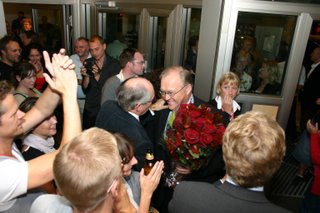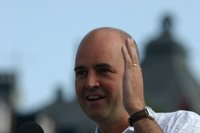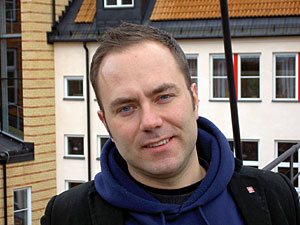There is a saying suggesting that the opposition doesn’t win elections. It is the sitting government who loses. However, before listing some explanations to why the Swedish Social Democratic Party (SAP) just ended up with the
lowest share of the popular vote since 1914 (35 percent), we must acknowledge a strategy that allowed the Conservative Party to get its
highest share of the vote since 1928 (26,2 percent).
Triangulation is a political strategy implying that you should position yourself close to your political opponent, steal the opponent’s best arguments, and create an image of yourself as the fresh alternative of the future, compared to the ruling government of the past. Think Clinton 1992, Blair 1997, Schröder 1998, and so on.
The Swedish Conservative Party managed to
implement this strategy perfectly. They claimed that they would spend as much as the Social Democrats on welfare; they managed to get hold of our two best arguments (employment and the ability to govern); and Fredrik Reinfeldt won the presidential battle of the future against Göran Persson (to a large extent thanks to a very biased media coverage). Fredrik Reinfeldt showed up in the last debate with a plaster on his finger. He had hurt himself while doing some domestic work with his family, and had used his kids’ Pippi Longstocking plaster. The contrast with Göran Persson, who has moved to a big house in the countryside, was effective.
But at the same time, Sweden’s economy is growing by 5,5 percent, employment is rising and life in the welfare state is pretty sweet for most people. In order to understand why the Social Democratic Party lost, one has to consider some problems in our own campaign.
1. The vital center/Stockholm/jobs: We tried to counter their attack into the political midfield through rallying our base. It did not work. We lost ten percentage points among old age pensioners (from 44 to 34 percent); we lost five percentage points among members of the blue color union LO (from 59 to 54 percent); the support among voters born outside the Nordic countries for the Left party and us shrank from 73 to 48 percent.
Moreover, in Stockholm City we got 23 percent of the popular vote, and in Stockholm County we got 26 percent. You cannot win elections and perceive yourself as a 40-percent-party if you get a quarter of the votes in the growing, dynamic region were Swedes (and swing voters) move.
One main reason explaining why we lost both core voters and swing voters is because the conservative alliance won the debate about jobs. We had good policies for growth and jobs, but we did not talk about that, and ended up as the party of welfare (and not
growth, jobs, and welfare). Somewhere in there, we lost our historic contract between the working class and the middle class (i.e. our polices benefit both groups, since we use market economy to create a more equal society for everyone, which appeals to the brains and hearts and wallets of rather rich people as well). When the Conservatives positioned themselves very close to us, they did not look as the big threat to the Swedish model anymore. Voters then moved from us to them.
2. Election strategy: All Social Democratic campaigns starts by acknowledging that although we are in government, we are in opposition to injustices, and we want to change society for the better. This time, we often ended up saying: “look, Sweden is great, the jobs are coming, vote for us again”. But the voters still saw some cracks in the welfare state, and were surprised that we did not talk more about that. Also, I guess we were afraid of using the same message a third time in a row (“we are in opposition to injustice and we want to spend more money on welfare”), fearing we would not be credible. A combination of a sound realization of the problems in Sweden, a distinct growth/jobs message, and a vision of a more equal and sustainable welfare state would have been perfect. (To be fair, those things were part of our message, but should have been even more in focus).
Moreover, we should have been tougher during the last two years, explaining how the “new right” still wants to dismantle the welfare state (they were allowed to gain a new image
and the political middle ground without much opposition). We should also be harsher vis-à-vis their new, dirty campaign methods.
Lastly, I think we should have focused more on some issues where we are strong and they are weak, which could have rallied our base and attract voters in the center at same time. Examples of such issues could be some of the
five “f:s”:
females/gender equality,
fags/LesBiGay issues,
foreigners/the rights of and discrimination against immigrants,
foreign aid/international issues, and
flowers/the green welfare state.
3. Fatigue/time for a change: Ruling governments in post-Cold War Western Europe normally lose around three percentage points when they try to get re-elected. We tried to get re-elected a fourth time, with the same leader we have had for the last 10 years. Naturally, it is easy to build a “time for a change” mood against that, especially when the media was happy to play that tune as well.
So, y'all: Sorry if this update took a few days, and ended up too long, but I just have to say one more thing. The most important date in this election campaign was the 10th of September 2003, as the magazine Focus concluded. The murder of Anna Lindh changed everything for the SAP, and we are now in a situation were we have lost both the general election and our future leader. That’s quite a challenge, but I strongly feel that a new generation of Social Democrats already has accepted the new political landscape and we are ready to fight back.
As Joe Hill said and as loads of people are saying now: "Don’t waste any time mourning - organize!"






